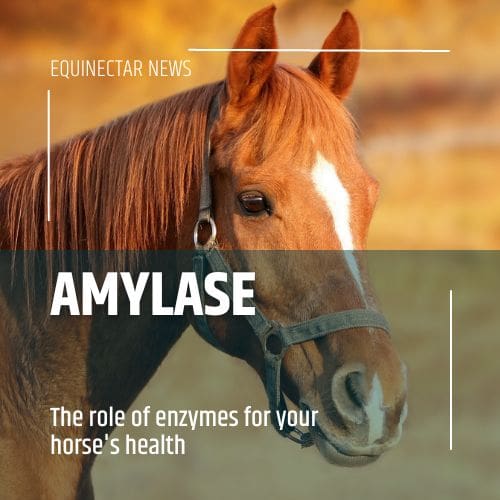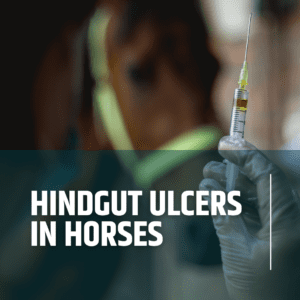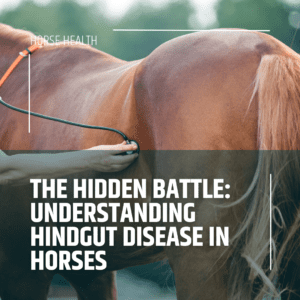What is the role of amylase in a horse?
The role of amylase in a horse is to break down complex carbohydrates, such as starch, into simpler sugars like glucose. This process aids in the digestion of food and helps the horse obtain energy from their diet.
Amylase is a crucial enzyme in equine digestion (1). Horses have limited capacity to digest starch in the small intestine compared to other mammals (2). This makes the role of amylase even more critical in their digestive process. The enzyme helps to initiate the breakdown of complex carbohydrates, making them more accessible for further digestion and absorption in the small intestine (5).
How do horses produce amylase?
Horses produce amylase in their salivary glands and pancreas. When a horse eats, the salivary glands release amylase into the mouth, where it begins to break down complex sugars in the food. This process helps to pre-digest the food before it reaches the stomach and intestines, where the rest of the digestive process takes place. The pancreas also produces amylase, which is released into the small intestine to continue the process of breaking down complex sugars into simpler sugars like glucose.
A study by Radicke et al. (1991) in the Journal of Animal Physiology and Animal Nutrition found that salivary amylase activity in horses is relatively low compared to that of humans or pigs (3). However, it still plays a crucial role in initiating starch digestion. The pancreatic amylase, released later in the digestive process, is more significant in terms of overall starch digestion capacity (4). This dual-source production of amylase (salivary and pancreatic) allows for a more efficient breakdown of complex carbohydrates throughout the digestive tract (5).
What happens if a horse eats more starch than they are able to digest?
If a horse eats more starch than they are able to digest, the excess starch can pass through their intestines undigested and ferment in the hindgut. This can lead to the production of excess gas and can cause digestive discomfort for the horse. In severe cases, it can lead to the development of digestive disorders such as colic or laminitis.
When undigested starch reaches the hindgut, it can be rapidly fermented by the microbial population, leading to a sudden drop in pH (2). This acidic environment can disrupt the normal microbial balance, potentially causing hindgut acidosis, which is associated with various health issues including colic and laminitis (6).
How could supplementary amylase help a horse digest starch?
Supplementary amylase can help a horse digest starch by providing more amylase to break down complex carbohydrates into simpler sugars. This can aid in the digestion of high-starch feeds and help the horse to more efficiently extract energy from their diet. In cases where a horse may have a deficiency in their own production of amylase, supplementary amylase can help to support their digestive health.
In general, supplementary amylase could potentially enhance starch digestion in the small intestine, reducing the amount of undigested starch reaching the hindgut and mitigating associated risks.
Can amylase help support a healthy microbiome in horses?
Yes, amylase can help support a healthy microbiome in horses. The microbiome is the community of bacteria and other microorganisms that live in the horse’s gut. These microorganisms play a crucial role in the horse’s digestive health and overall well-being. By breaking down complex sugars into simpler sugars like glucose, amylase helps to support the growth and proliferation of beneficial bacteria in the microbiome.
Amylase’s action on starch can influence microbial populations. By breaking down starch into simpler sugars, amylase can help prevent excessive amounts of undigested starch from reaching the hindgut (7). This is crucial because large amounts of undigested starch can lead to rapid fermentation and disrupt the delicate microbial balance in the hindgut. Therefore, efficient amylase activity indirectly supports a healthy microbiome by promoting a more stable environment in the hindgut.
Does EquiNectar contain amylase?
Yes. The amylase within EquiNectar comes from the sprouting barley grain that is the key ingredient in EquiNectar. It is a natural source of amylase.
Sprouted grains are known to have increased enzyme activity, including amylase (8). This natural increase in amylase during sprouting makes sprouted barley an excellent source of this enzyme. The inclusion of sprouted barley in EquiNectar thus provides a natural, food-based source of amylase, which aligns with the preference for natural dietary supplements in equine nutrition.
References:
[1] Richards, N & Choct, Mingan & Hinch, GN & Rowe, JB. (2003). Equine α-amylase: does it limit starch digestion in the small intestine of the horse?. Conference: Recent Advances in Animal Nutrition in Australia, 14. https://www.researchgate.net/publication/289519341_Equine_a-amylase_does_it_limit_starch_digestion_in_the_small_intestine_of_the_horse
[2] Auwerda, P.(n.d.). Digestive Anatomy and Physiology of the Horse. IOWA State University. https://www.extension.iastate.edu/equine/blog/dr-peggy-m-auwerda/digestive-anatomy-and-physiology-horse
[3] Radicke, S., Kienzle, E., & Meyer, H. (1991). Preileal apparent digestibility of oats and corn starch and consequences for cecal metabolism. In Proceedings of the 12th Equine Nutrition and Physiology Symposium. Calgary, Alberta, Canada: Equine Nutrition and Physiology Society.
[4] Azzopardi, E., Surg, Lloyd, C., Teixeira, S., Conlan, S., & Whitaker, I. (2016). Clinical applications of amylase: Novel perspectives. Surgery, 160(1), 26-37. https://www.sciencedirect.com/science/article/abs/pii/S0039606016000428
[5] Pieper-Bigelow, C., Strocchi, A., & Levitt, M. D. (1990). Where does serum amylase come from and where does it go?. Gastroenterology clinics of North America, 19(4), 793–810. https://pubmed.ncbi.nlm.nih.gov/1702756/
[6] Al Jassim, R. A., & Andrews, F. M. (2009). The bacterial community of the horse gastrointestinal tract and its relation to fermentative acidosis, laminitis, colic, and stomach ulcers. The Veterinary clinics of North America. Equine practice, 25(2), 199–215. https://doi.org/10.1016/j.cveq.2009.04.005
[7] Contreras-Aguilar, M. D., Martínez-Subiela, S., Cerón, J. J., Martín-Cuervo, M., Tecles, F., & Escribano, D. (2019). Salivary alpha-amylase activity and concentration in horses with acute abdominal disease: Association with outcome. Equine veterinary journal, 51(5), 569–574. https://doi.org/10.1111/evj.13066
[8] Troya, L., Blanco, J., & Re, R. (2020). Comparison of the colic incidence in a horse population with or without inclusion of germinated barley in the diet. Equine Veterinary Education, 32(11), 28-32. https://beva.onlinelibrary.wiley.com/doi/abs/10.1111/eve.13274





